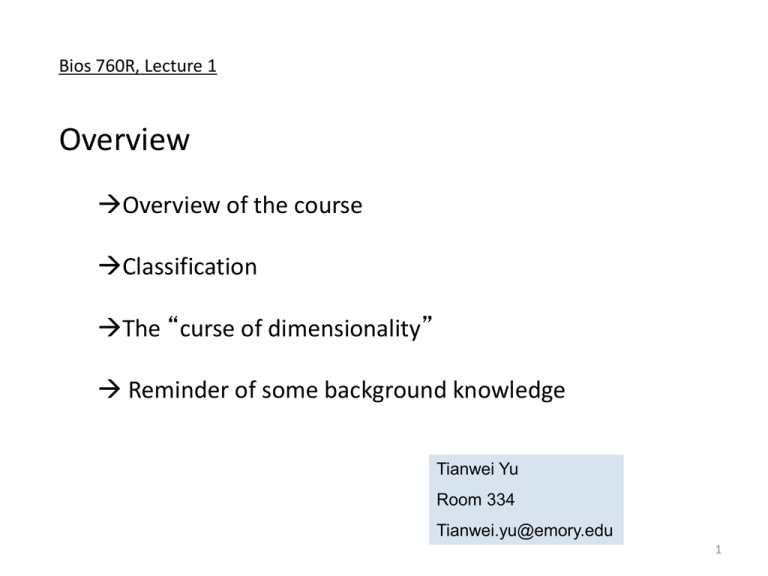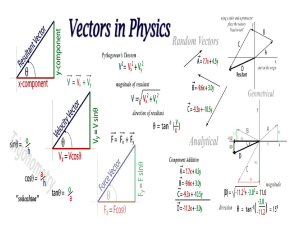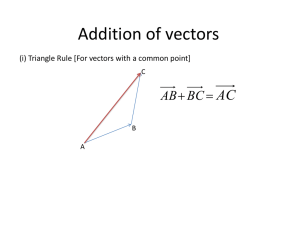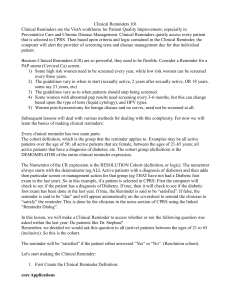Lecture 1: Overview
advertisement

Bios 760R, Lecture 1
Overview
Overview of the course
Classification
The “curse of dimensionality”
Reminder of some background knowledge
Tianwei Yu
Room 334
Tianwei.yu@emory.edu
1
Overview
Lecture 1
Overview
Lecture 2
Bayesian decision theory
Lecture 3
Density estimation
Lecture 4
Linear machine
Classification
Lecture 5
Neural network
Clustering
Lecture 6
Support vector machine
Dimension reduction
Lecture 7
Tree and forest
Lecture 8
Bump hunting
Lecture 9
Boosting
Lecture 10
Model generalization
Lecture 11
Similarity measures, Hierarchical
clustering, Subspace clustering
Lecture 12
Center-based & Model-based
clustering
Lecture 13
PCA, SIR
Lecture 14
ICA, PLSDA
Focus of the course:
2
Overview
References:
Textbook:
The elements of statistical learning. Hastie, Tibshirani &
Friedman.
Other references:
Pattern classification. Duda, Hart & Stork.
Data clustering: theory, algorithms and application. Gan, Ma &
Wu.
Applied multivariate statistical analysis. Johnson & Wichern.
Evaluation:
Three projects (30% each)
Class participation (10%)
3
Overview
Supervised learning
”direct data mining”
Classification
Estimation
Prediction
Unsupervised learning
”indirect data mining”
Clustering
Association rules
Description, dimension
reduction and
visualization
Machine Learning
/Data mining
Semi-supervised learning
Modified from Figure 1.1 from <Data Clustering> by Gan, Ma and Wu
4
Overview
In supervised learning, the problem is well-defined:
Given a set of observations {xi, yi},
estimate the density Pr(Y, X)
Usually the goal is to find the model/parameters to
minimize a loss,
A common loss is Expected Prediction Error:
It is minimized at
Objective criteria exists to measure the success of a supervised
learning mechanism.
5
Overview
In unsupervised learning, there is no output variable, all we
observe is a set {xi}.
The goal is to infer Pr(X) and/or some of its properties.
When the dimension is low, nonparametric density estimation is
possible;
When the dimension is high, may need to find simple properties
without density estimation, or apply strong assumptions to
estimate the density.
There is no objective criteria to evaluate the outcome;
Heuristic arguments are used to motivate the methods;
Reasonable explanation of the outcome is expected from the
subjective field of study.
6
Classification
The general scheme.
An example.
7
Classification
In most cases, a single
feature is not enough to
generate a good
classifier.
8
Classification
Two extremes:
overly rigid and
overly flexible
classifiers.
9
Classification
Goal: an optimal trade-off between model simplicity and training
set performance.
This is similar to the AIC / BIC / …… model selection in
regression.
10
Classification
An example of the overall
scheme involving
classification:
11
Classification
A classification
project:
a systematic view.
12
Curse of Dimensionality
Bellman R.E.,
1961.
In p-dimensions, to get a hypercube with volume r, the edge length
needed is r1/p.
In 10 dimensions, to capture 1% of the data to get a local average,
we need 63% of the range of each input variable.
13
Curse of Dimensionality
In other words,
To get a “dense” sample, if we need N=100 samples in 1
dimension, then we need N=10010 samples in 10 dimensions.
In high-dimension, the data is always sparse and do not support
density estimation.
More data points are closer to the boundary, rather than to any
other data point prediction is much harder near the edge of the
training sample.
14
Curse of
Dimensionality
Estimating a 1D
density with 40
data points.
Standard normal
distribution.
15
Curse of
Dimensionality
Estimating a 2D
density with 40
data points.
2D normal
distribution; zero
mean; variance
matrix is identity
matrix.
16
Curse of Dimensionality
Another example – the EPE of the nearest neighbor predictor.
To find E(Y|X=x), take the average of data points close to a given x, i.e. the
top k nearest neighbors of x
Assumes f(x) is well-approximated
by a locally constant function
When N is large, the neighborhood
is small, the prediction is accurate.
17
Curse of Dimensionality
Just a reminder, the
expected prediction error
contains variance and bias
components.
Under model:
Y=f(X)+ε
EPE ( x0 ) = E[(Y - fˆ ( x0 )) 2 ]
= E[(e 2 + 2e ( f ( x0 ) - fˆ ( x0 )) + ( f ( x0 ) - fˆ ( x0 )) 2 )]
= s 2 + E[( f ( x ) - fˆ ( x )) 2 ]
0
0
= s 2 + E[ fˆ ( x0 ) - E ( fˆ ( x0 ))]2 + [ E ( fˆ ( x0 )) - f ( x0 )]2
= s 2 + Var ( fˆ ( x )) + Bias 2 ( fˆ ( x ))
0
0
18
Curse of Dimensionality
We have talked about the curse of dimensionality in the
sense of density estimation.
In a classification problem, we do not necessarily need
density estimation.
Generative model --- care about class density function.
Discriminative model --- care about boundary.
Example: Classifying belt fish and carp. Looking at the
length/width ratio is enough. Why should we care how many
teeth each kind of fish have, or what shape fins they have?
19
High-throughput biological data
We talk about “curse of dimensionality” when N is not >>>p.
In bioinformatics, usually N<100, and p>1000.
How to deal with this N<<p issue? It is assumed most
predictors do not contain information to predict Y.
Dramatically reduce p before model-building.
Filter genes based on:
variation.
normal/disease test statistic.
projection.
functional groups/network
modules.
……
For the most part of this course, we will pretend the N<<p issue
doesn’t exist. Some methods are robust against large
20
numbers of nuisance variables.
Reminder of some results for random vectors
The multivariate Gaussian distribution:
The covariance
matrix, not limited to
Gaussian.
* Gaussian is fully
defined by mean
vector and covariance
matrix (first and
second moments).
21
Reminder of some results for random vectors
The correlation matrix:
Relationship with covariance matrix:
V
1
1
2
V rV
2
[
= diag s ii
1
2
]
=S
22
Reminder of some results for random vectors
k
k
x ¢Ax = å å aij x i x j
Quadratic form:
i=1 j=1
A linear combination of the elements of a random vector:
2
Var(aX
+
bX
)
=
E[(aX
+
bX
)
(a
m
+
b
m
)]
1
2
1
2
1
2
2-D example:
= E[a(X1 - m1 ) + b(X 2 - m2 )]2
és11 s12 ùéaù
= a s11 + b s 22 + 2abs12 = [a b]ê
úê ú = c ¢Sc
ës12 s 22 ûëbû
2
2
23
Reminder of some results for random vectors
A “new” random vector generated from linear combinations of a
random vector:
24
Reminder of some results for random vectors
Let A be a kxk square symmetrix matrix, then it has k pairs of eigenvalues
and eigenvectors. A can be decomposed as:
A = l1e1e1¢ + l2e2e2¢ + ....... + lkekek¢ = PLP ¢
Positive-definite matrix:
x ¢Ax > 0,"x ¹ 0
l1 ³ l2 ³ ...... ³ lk > 0
Note : x ¢Ax = l1 ( x ¢e1 ) 2 + ...... + lk ( x ¢ek ) 2
Reminder of some results for random vectors
Inverse of a positive-definite matrix:
k
A = PL P ¢ = å
-1
-1
i=1
1
li
eiei¢
Square root matrix of a positive-definite matrix:
k
A1 2 = PL 2 P ¢ = å li eiei¢
1
i=1
Reminder of some results for random vectors
27
Reminder of some results for random vectors
Proof of the first (and second) point of the previous slide.
28
Reminder of some results for random vectors
With a sample of the random vector:
29
Reminder of some results for random vectors
To estimate mean vector and covariance matrix:
⌢
m=X
n
⌢
1
¢
S=S=
X
X
X
X
(
)
(
)
å
i
i
n -1 i=1
30
Reminder of some results for random vectors
31
Reminder of some results for random vectors
32
Reminder of some results for random vectors
33









